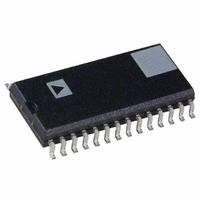AD73322LAR Analog Devices Inc, AD73322LAR Datasheet - Page 27

AD73322LAR
Manufacturer Part Number
AD73322LAR
Description
IC ANALOG FRONT END DUAL 28-SOIC
Manufacturer
Analog Devices Inc
Datasheet
1.AD73322LARZ.pdf
(48 pages)
Specifications of AD73322LAR
Rohs Status
RoHS non-compliant
Number Of Bits
16
Number Of Channels
4
Power (watts)
73mW
Voltage - Supply, Analog
2.7 V ~ 5.5 V
Voltage - Supply, Digital
2.7 V ~ 5.5 V
Package / Case
28-SOIC (7.5mm Width)
Available stocks
Company
Part Number
Manufacturer
Quantity
Price
Company:
Part Number:
AD73322LARU
Manufacturer:
LINEA
Quantity:
5
Company:
Part Number:
AD73322LARUZ
Manufacturer:
AD
Quantity:
760
Part Number:
AD73322LARUZ
Manufacturer:
ADI/亚德诺
Quantity:
20 000
INTERFACING
The AD73322L can be interfaced to most modern DSP engines
using conventional serial port connections and an extra enable
control line. Both serial input and output data use an accom-
panying frame synchronization signal that is active high one
clock cycle before the start of the 16-bit word or during the last
bit of the previous word if transmission is continuous. The
serial clock (SCLK) is an output from the codec and is used
to define the serial transfer rate to the DSP’s Tx and Rx ports.
Two primary configurations can be used: the first is shown in
Figure 22 where the DSP’s Tx data, Tx frame sync, Rx data, and
Rx frame sync are connected to the codec’s SDI, SDIFS, SDO,
and SDOFS, respectively. This configuration, referred to as
indirectly coupled or nonframe sync loop-back, has the effect of
decoupling the transmission of input data from the receipt of
output data. The delay between receipt of codec output data and
transmission of input data for the codec is determined by the
DSP’s software latency.
When programming the DSP serial port for this configuration,
it is necessary to set the Rx FS as an input and the Tx FS as an
output generated by the DSP. This configuration is most useful
when operating in mixed mode, as the DSP has the ability to
decide how many words (either DAC or control) can be sent to
the codecs. This means that full control can be implemented
over the device configuration as well as updating the DAC in a
given sample interval.
The second configuration (shown in Figure 24) has the DSP’s
Tx data and Rx data connected to the codec’s SDI and SDO,
respectively, while the DSP’s Tx and Rx frame syncs are
connected to the codec’s SDIFS and SDOFS. In this
configuration, referred to as directly coupled or frame sync
loop-back, the frame sync signals are connected together and
the input data to the codec is forced to be synchronous with the
output data from the codec. The DSP must be programmed so
that both the Tx FS and Rx FS are inputs as the codec SDOFS is
input to both. This configuration guarantees that input and
output events occur simultaneously and is the simplest
configuration for operation in normal data mode. When
programming the DSP in this configuration, it is advisable to
preload the Tx register with the first control word to be sent
before the codec is taken out of reset. This ensures that this
word is transmitted to coincide with the first output word from
the device(s).
Rev. A | Page 27 of 48
CASCADE OPERATION
The AD73322L has been designed to support cascading of
codecs from a single DSP serial port (see Figure 36). Cascaded
operation can support mixes of dual- or single-channel devices
with the maximum number of codec units being eight (the
AD73322L is equivalent to two codec units). The SPORT
interface protocol has been designed so that device addressing
is built into the packet of information sent to the device. This
allows the cascade to be formed with no extra hardware
overhead for control signals or addressing. A cascade can be
formed in either of the two modes previously discussed.
There may be some restrictions in cascade operation due to the
number of devices configured in the cascade and the sampling
rate and serial clock rate chosen. The following relationship
details the restrictions in configuring a codec cascade.
When using the indirectly coupled frame sync configuration
in cascaded operation, be aware of the restrictions in sending
data to all devices in the cascade. Effectively the time allowed is
given by the sampling interval (M/DMCLK—where M can be
256, 512, 1024, or 2048), which is 125 µs for a sample rate of
8 kHz. In this interval, the DSP must transfer N × 16 bits of
information where N is the number of devices in the cascade.
ADSP-21xx
ADSP-21xx
Figure 24. Directly Coupled or Frame Sync Loop-Back Configuration
Number of Codes × Word Size (16) × Sampling Rate ≤
Serial Clock Rate
DSP
DSP
Figure 23. Indirectly Coupled or Nonframe Sync
TFS
DT
SCLK
DR
RFS
TFS
DT
SCLK
DR
RFS
Loop-Back Configuration
SDOFS
SDOFS
SDIFS
SDIFS
SCLK
SCLK
SDO
SDO
SDI
SDI
CODEC1
CODEC2
CODEC1
CODEC2
AD73322L
AD73322L
AD73322L
CODEC
CODEC













